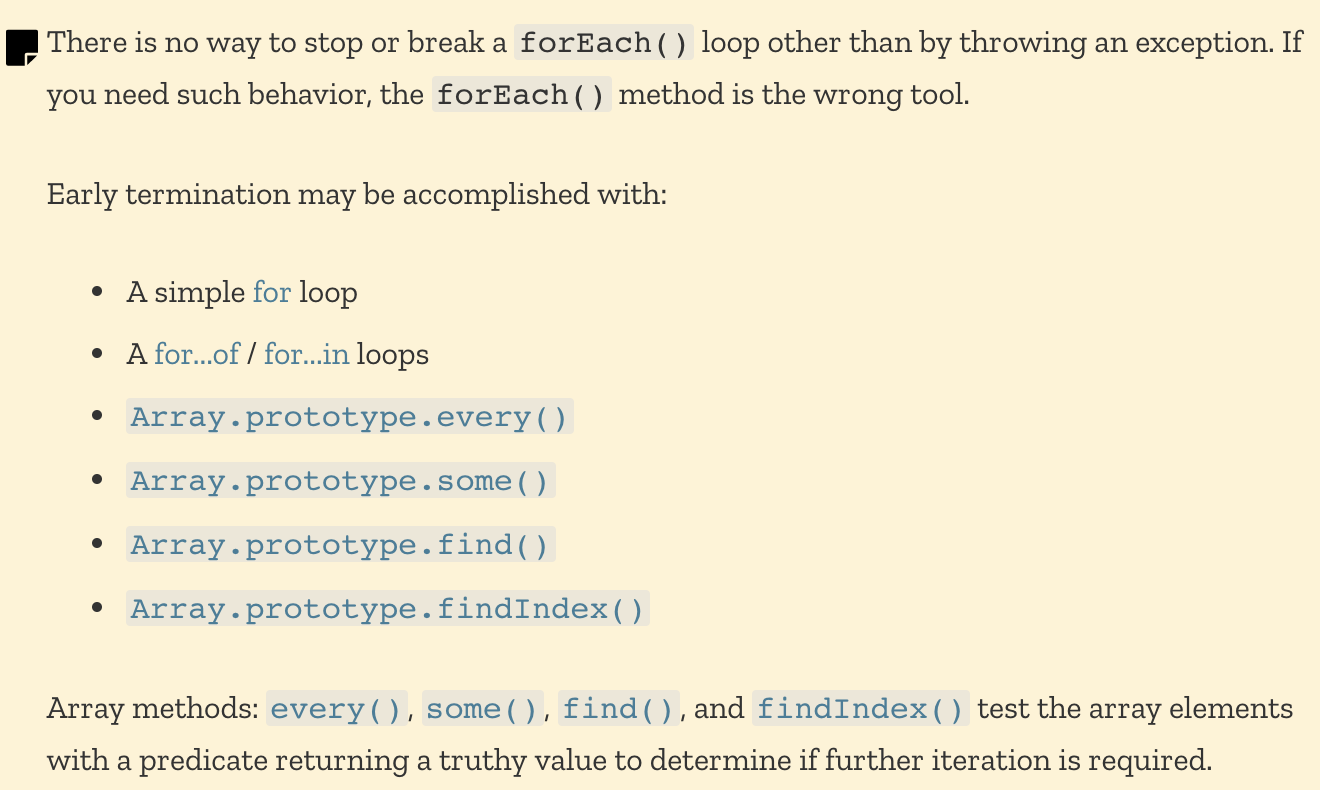Array 原型方法源码实现大解密
引言
几个常用数组方法的使用方式已经在【进阶 6-1 期】 中介绍过了,今天这篇文章主要看看 ECMA-262 规范中是如何定义这些方法的,并且在看完规范后我们用 JS 模拟实现下,透过源码探索一些底层的知识,希望本文对你有所帮助。
Array.prototype.map
完整的结构是 Array.prototype.map(callbackfn[, thisArg]),map 函数接收两个参数,一个是必填项回调函数,另一个是可选项 callbackfn 函数执行时的 this 值。
map 方法的主要功能就是把原数组中的每个元素按顺序执行一次 callbackfn 函数,并且把所有返回的结果组合在一起生成一个新的数组,map 方法的返回值就是这个新数组。
ECMA-262 规范文档实现如下。
展开查看规范
- Let O be ? ToObject(this value).
- Let len be ? LengthOfArrayLike(O).
- If IsCallable(callbackfn) is false, throw a TypeError exception.
- If thisArg is present, let T be thisArg; else let T be undefined.
- Let A be ? ArraySpeciesCreate(O, len).
- Let k be 0.
- Repeat, while k < len
- Let Pk be ! ToString(k).
- Let kPresent be ? HasProperty(O, Pk).
- If kPresent is true, then
- Let kValue be ? Get(O, Pk).
- Let mappedValue be ? Call(callbackfn, T, « kValue, k, O »).
- Perform ? CreateDataPropertyOrThrow(A, Pk, mappedValue).
- Set k to k + 1.
- Return A.
用 JS 来模拟实现,核心逻辑如下:
Array.prototype.map = function(callbackfn, thisArg) {
// 异常处理
if (this == null) {
throw new TypeError("Cannot read property 'map' of null or undefined");
}
// Step 1. 转成数组对象,有 length 属性和 K-V 键值对
let O = Object(this)
// Step 2. 无符号右移 0 位,左侧用 0 填充,结果非负
let len = O.length >>> 0
// Step 3. callbackfn 不是函数时抛出异常
if (typeof callbackfn !== 'function') {
throw new TypeError(callbackfn + ' is not a function')
}
// Step 4.
let T = thisArg
// Step 5.
let A = new Array(len)
// Step 6.
let k = 0
// Step 7.
while(k < len) {
// Step 7.1、7.2、7.3
// 检查 O 及其原型链是否包含属性 k
if (k in O) {
// Step 7.3.1
let kValue = O[k]
// Step 7.3.2 执行 callbackfn 函数
// 传入 this, 当前元素 element, 索引 index, 原数组对象 O
let mappedValue = callbackfn.call(T, kValue, k, O)
// Step 7.3.3 返回结果赋值给新生成数组
A[k] = mappedValue
}
// Step 7.4
k++
}
// Step 8. 返回新数组
return A
}
// 代码亲测已通过
看完代码其实挺简单,核心就是在一个 while 循环中执行 callbackfn,并传入 4 个参数,回调函数具体的执行逻辑这里并不关心,只需要拿到返回结果并赋值给新数组就好了。
只有 O 及其原型链上包含属性 k 时才会执行 callbackfn 函数,所以对于稀疏数组 empty 元素或者使用 delete 删除后的索引则不会被调用。
let arr = [1, , 3, , 5]
console.log(0 in arr) // true
delete arr[0]
console.log(0 in arr) // false
console.log(arr) // [empty × 2, 3, empty, 5]
arr.map(ele => {
console.log(ele) // 3, 5
})
map 并不会修改原数组,不过也不是绝对的,如果你在 callbackfn 中修改了原数组,那还是会改变。那问题来了,修改后会影响到 map 自身的执行吗?
答案是会的!不过得区分以下几种情况。
- 原数组新增元素:因为
map第一次执行时 length 已经确定了,所以不影响 - 原数组修改元素:传递给
callbackfn的元素是 map 遍历到它们那一瞬间的值,所以可能受影响- 修改当前索引之前的元素,不受影响
- 修改当前索引之后的元素,受影响
- 原数组删除元素:被删除的元素无法被访问到,所以可能受影响
- 删除当前索引之前的元素,已经访问过了,所以不受影响
- 删除当前索引之后的元素,受影响
简单看下面几个例子,在 callbackfn 中不要改变原数组,不然会有意想不到的情况发生。
// 1、原数组新增元素,不受影响
let arr = [1, 2, 3]
let result = arr.map((ele, index, array) => {
array.push(4);
return ele * 2
})
console.log(result)
// 2, 4, 6
// ----------- 完美分割线 -----------
// 2、原数组修改当前索引之前的元素,不受影响
let arr = [1, 2, 3]
let result = arr.map((ele, index, array) => {
if (index === 1) {
array[0] = 4
}
return ele * 2
})
console.log(result)
// 2, 4, 6
// ----------- 完美分割线 -----------
// 3、原数组修改当前索引之后的元素,受影响
let arr = [1, 2, 3]
let result = arr.map((ele, index, array) => {
if (index === 1) {
array[2] = 4
}
return ele * 2
})
console.log(result)
// 2, 4, 8
最后来说说 this,源码中有这么一段 callbackfn.call(T, kValue, k, O),其中 T 就是 thisArg 值,如果没有设置,那就是 undefined。
根据【进阶 3-3 期】 中对于 call 的解读,传入 undefined 时,非严格模式下指向 Window,严格模式下为 undefined。记住这时候回调函数不能用箭头函数,因为箭头函数是没有自己的 this 的。
// 1、传入 thisArg 但使用箭头函数
let name = 'Muyiy'
let obj = {
name: 'Hello',
callback: (ele) => {
return this.name + ele
}
}
let arr = [1, 2, 3]
let result = arr.map(obj.callback, obj);
console.log(result)
// ["1", "2", "3"],此时 this 指向 window
// 那为啥不是 "Muyiy1" 这样呢,不急,第 3 步介绍
// ----------- 完美分割线 -----------
// 2、传入 thisArg,使用普通函数
let name = 'Muyiy'
let obj = {
name: 'Hello',
callback: function (ele) {
return this.name + ele
}
}
let arr = [1, 2, 3]
let result = arr.map(obj.callback, obj);
console.log(result)
// ["Hello1", "Hello2", "Hello3"],完美
// ----------- 完美分割线 -----------
// 3、不传入 thisArg,name 使用 let 声明
let name = 'Muyiy'
let obj = {
name: 'Hello',
callback: function (ele) {
return this.name + ele
}
}
let arr = [1, 2, 3]
let result = arr.map(obj.callback);
console.log(result)
// ["1", "2", "3"]
// 为什么呢,因为 let 和 const 声明的变量不会挂载到 window 上
// ----------- 完美分割线 -----------
// 4、不传入 thisArg,name 使用 var 声明
var name = 'Muyiy'
let obj = {
name: 'Hello',
callback: function (ele) {
return this.name + ele
}
}
let arr = [1, 2, 3]
let result = arr.map(obj.callback);
console.log(result)
// ["Muyiy1", "Muyiy2", "Muyiy3"]
// 看看,改成 var 就好了
// ----------- 完美分割线 -----------
// 5、严格模式
'use strict'
var name = 'Muyiy'
let obj = {
name: 'Hello',
callback: function (ele) {
return this.name + ele
}
}
let arr = [1, 2, 3]
let result = arr.map(obj.callback);
console.log(result)
// TypeError: Cannot read property 'name' of undefined
// 因为严格模式下 this 指向 undefined
上面这部分实操代码介绍了 5 种情况,分别是传入 thisArg 两种情况,非严格模式下两种情况,以及严格模式下一种情况。这部分的知识在之前的文章中都有介绍过,这里主要是温故下。如果这块知识不熟悉,可以详细看我的 博客
Array.prototype.filter
完整的结构是 Array.prototype.filter(callbackfn[, thisArg]),和 map 是一样的。
filter 字如其名,它的主要功能就是过滤,callbackfn 执行结果如果是 true 就返回当前元素,false 则不返回,返回的所有元素组合在一起生成新数组,并返回。如果没有任何元素通过测试,则返回空数组。
所以这部分源码相比 map 而言,多了一步判断 callbackfn 的返回值。
ECMA-262 规范文档实现如下。
展开查看规范
Let O be ? ToObject(this value).
Let len be ? LengthOfArrayLike(O).
If IsCallable(callbackfn) is false, throw a TypeError exception.
If thisArg is present, let T be thisArg; else let T be undefined.
Let A be ? ArraySpeciesCreate(O, 0).
Let k be 0.
Let to be 0.
Repeat, while k < len
- Let Pk be ! ToString(k).
- Let kPresent be ? HasProperty(O, Pk).
- If kPresent is true, then
- Let kValue be ? Get(O, Pk).
- Let selected be ! ToBoolean(? Call(callbackfn, T, « kValue, k, O »)).
- If selected is true, then
- Perform ? CreateDataPropertyOrThrow(A, ! ToString(to), kValue).
- Set to to to + 1.
- Set k to k + 1.
Return A.
用 JS 来模拟实现,核心逻辑如下:
Array.prototype.filter = function(callbackfn, thisArg) {
// 异常处理
if (this == null) {
throw new TypeError("Cannot read property 'map' of null or undefined");
}
if (typeof callbackfn !== 'function') {
throw new TypeError(callbackfn + ' is not a function')
}
let O = Object(this), len = O.length >>> 0,
T = thisArg, A = new Array(len), k = 0
// 新增,返回数组的索引
let to = 0
while(k < len) {
if (k in O) {
let kValue = O[k]
// 新增
if (callbackfn.call(T, kValue, k, O)) {
A[to++] = kValue;
}
}
k++
}
// 新增,修改 length,初始值为 len
A.length = to;
return A
}
// 代码亲测已通过
看懂 map 再看这个实现就简单多了,改动点在于判断 callbackfn 返回值,新增索引 to,这样主要避免使用 k 时生成空元素,并在返回之前修改 length 值。
这部分源码还是挺有意思的,惊喜点在于 A.length = to,之前还没用过。
Array.prototype.reduce
reduce 可以理解为「归一」,意为海纳百川,万剑归一,完整的结构是 Array.prototype.reduce(callbackfn[, initialValue]),这里第二个参数并不是 thisArg 了,而是初始值 initialValue,关于初始值之前有介绍过。
- 如果没有提供
initialValue,那么第一次调用callback函数时,accumulator使用原数组中的第一个元素,currentValue即是数组中的第二个元素。 - 如果提供了
initialValue,accumulator将使用这个初始值,currentValue使用原数组中的第一个元素。 - 在没有初始值的空数组上调用
reduce将报错。
ECMA-262 规范文档实现如下。
展开查看规范
Let O be ? ToObject(this value).
Let len be ? LengthOfArrayLike(O).
If IsCallable(callbackfn) is false, throw a TypeError exception.
If len is 0 and initialValue is not present, throw a TypeError exception.
Let k be 0.
Let accumulator be undefined.
If initialValue is present, then
- Set accumulator to initialValue.
Else,
- Let kPresent be false.
- Repeat, while kPresent is false and k < len
- Let Pk be ! ToString(k).
- Set kPresent to ? HasProperty(O, Pk).
- If kPresent is true, then
- Set accumulator to ? Get(O, Pk).
- Set k to k + 1.
- If kPresent is false, throw a TypeError exception.
Repeat, while k < len
- Let Pk be ! ToString(k).
- Let kPresent be ? HasProperty(O, Pk).
- If kPresent is true, then
- Let kValue be ? Get(O, Pk).
- Set accumulator to ? Call(callbackfn, undefined, « accumulator, kValue, k, O »).
- Set k to k + 1.
Return accumulator.
用 JS 来模拟实现,核心逻辑如下:
Array.prototype.reduce = function(callbackfn, initialValue) {
// 异常处理
if (this == null) {
throw new TypeError("Cannot read property 'map' of null or undefined");
}
if (typeof callbackfn !== 'function') {
throw new TypeError(callbackfn + ' is not a function')
}
let O = Object(this)
let len = O.length >>> 0
let k = 0, accumulator
// 新增
if (initialValue) {
accumulator = initialValue
} else {
// Step 4.
if (len === 0) {
throw new TypeError('Reduce of empty array with no initial value');
}
// Step 8.
let kPresent = false
while(!kPresent && (k < len)) {
kPresent = k in O
if (kPresent) {
accumulator = O[k]
}
k++
}
}
while(k < len) {
if (k in O) {
let kValue = O[k]
accumulator = callbackfn.call(undefined, accumulator, kValue, k, O)
}
k++
}
return accumulator
}
// 代码亲测已通过
这部分源码主要多了对于 initialValue 的处理,有初始值时比较简单,即 accumulator = initialValue,kValue = O[0]。
无初始值处理在 Step 8,循环判断当 O 及其原型链上存在属性 k 时,accumulator = O[k] 并退出循环,因为 k++,所以 kValue = O[k++]。
更多的数组方法有 find、findIndex、forEach 等,其源码实现也是大同小异,无非就是在 callbackfn.call 这部分做些处理,有兴趣的可以看看 TC39 和 MDN 官网,参考部分链接直达。
注意
forEach 的源码和 map 很相同,在 map 的源码基础上做些改造就是啦。
Array.prototype.forEach = function(callbackfn, thisArg) {
// 相同
...
while(k < len) {
if (k in O) {
let kValue = O[k]
// 这部分是 map
// let mappedValue = callbackfn.call(T, kValue, k, O)
// A[k] = mappedValue
// 这部分是 forEach
callbackfn.call(T, kValue, k, O)
}
k++
}
// 返回 undefined
// return undefined
}
可以看到,不同之处在于不处理 callbackfn 执行的结果,也不返回。
特意指出来是因为在此之前看到过一种错误的说法,叫做「forEach 会跳过空,但是 map 不跳过」
为什么说 map 不跳过呢,因为原始数组有 empty 元素时,map 返回的结果也有 empty 元素,所以不跳过,但是这种说法并不正确。
let arr = [1, , 3, , 5]
console.log(arr) // [1, empty, 3, empty, 5]
let result = arr.map(ele => {
console.log(ele) // 1, 3, 5
return ele
})
console.log(result) // [1, empty, 3, empty, 5]
看 ele 输出就会明白 map 也是跳空的,原因就在于源码中的 k in O,这里是检查 O 及其原型链是否包含属性 k,所以有的实现中用 hasOwnProperty 也是不正确的。
另外 callbackfn 中不可以使用 break 跳出循环,是因为 break 只能跳出循环,而 callbackfn 并不是循环体。如果有类似的需求可以使用for..of、for..in、 some、every 等。

熟悉源码之后很多问题就迎刃而解啦,感谢阅读。
参考



看完两件小事
如果你觉得这篇原创文章对你挺有启发,我想请你帮我两个小忙: